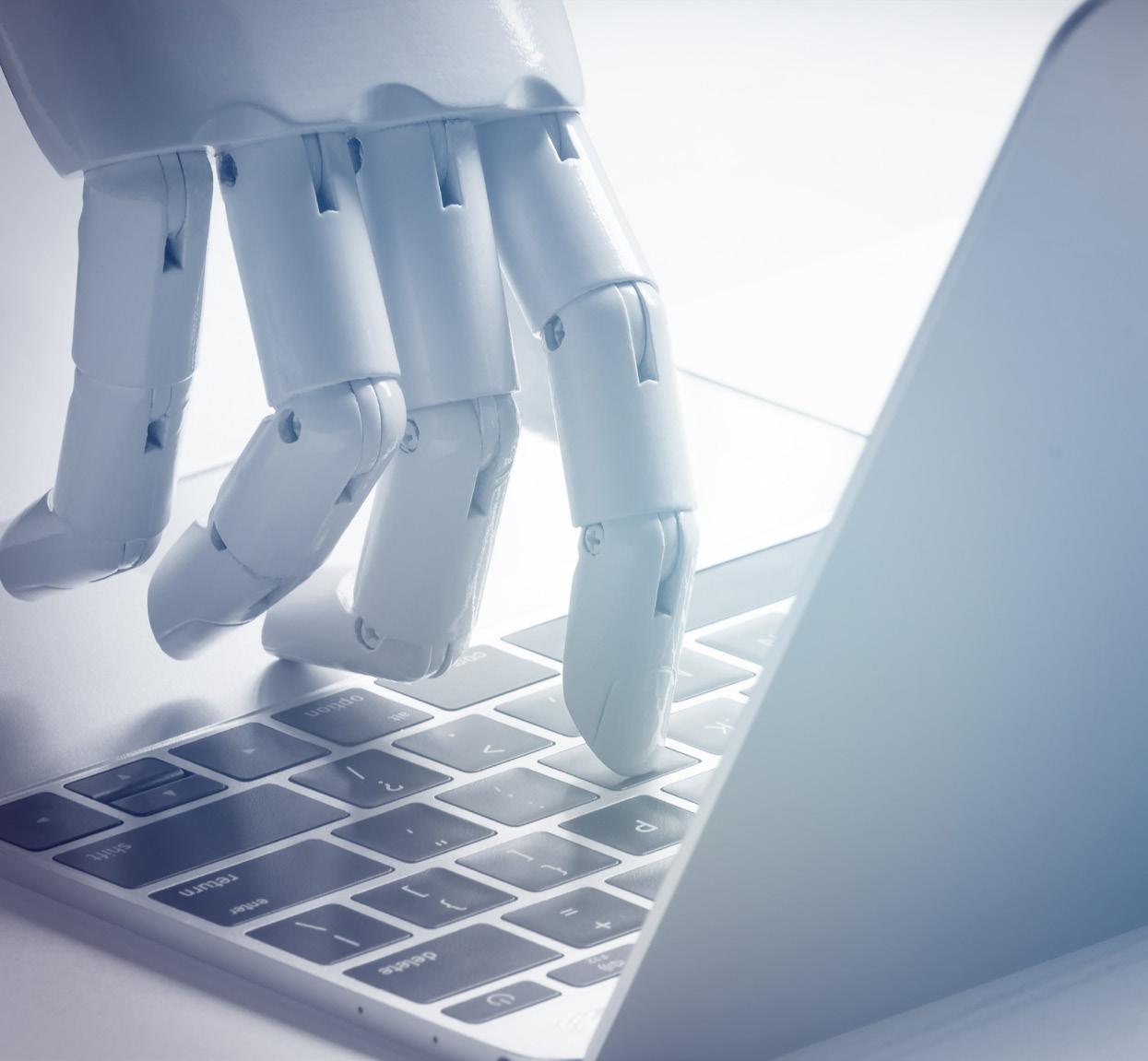
9 minute read
View from the inside
Disruptive technologies and artificial intelligence (AI) are becoming increasingly important tools for HR professionals. Kathy Catton speaks with tech companies around Aotearoa New Zealand, to find out how they leverage its power.
HR teams have a lot to gain from the ever-growing digital world and the Big Data it contains. What kinds of benefits are HR teams seeing, and how have they used IT to change the way they work with people? And what are the risks or pitfalls?
EMBRACING THE BENEFITS
Karly Boast is Vice-President of People at LawVu, the software and service company specialising in providing a virtual workspace for in-house legal teams around the globe. Based in Tauranga, Karly is a passionate believer in the power of tech as a force for good in the HR space.
“I think there’s a lot of apprehension about what the integration of ChatGPT and generative AI can mean for HR,” says Karly. “But if you approach it with curiosity and an open mindset, you can start to see how it can propel us forward, gain competitive advantage and make us better HR professionals.”
At LawVu, Karly is using tech and AI to do a large amount of HR’s work. “All our recruitment, candidate experience, onboarding, performance management and learning and development is done through Bamboo HR, Deel and other AI platforms,” says Karly. “It’s really useful for data reporting, seeing trends and gaining insights. We use this data to help make informed decisions at an executive level.”
For Karly and LawVu, the benefits of using tech and AI are significant. Response times are accelerated, errors are reduced and processes are streamlined. “The biggest thing is that it offers invaluable insights that help us make strategic decisions and make us impactful at the top table,” says Karly. “And it actually personalises the employee experience, through algorithms tailoring learning and development to each individual.”
Karly is also clear about the pitfalls of using a system of ‘one truth’. She says, “You’ve still got to do your research and get legal advice. But I firmly believe that innovation is not solely about embracing technology. It’s about recognising the intrinsic value of human-centric approaches and the power of emotional intelligence. By combining cutting-edge technology with a human touch, we can unlock new levels of productivity, engagement and growth.”

Onboarding Example
Rachael Hurren, GM People and Development at Inde Technology, an Aotearoa IT services company, states that the case for AI in most New Zealand-based small companies still needs to be justified.

“There needs to be a large amount of investment to train a ‘bot’ to assimilate all of our employment legislation and make it meaningful to the New Zealand audience,” says Rachael. “We can’t just take a US bot and expect it to apply to our environment.”
But the advantages of using technology are significant. Time-saving is an obvious benefit, as well as improved data accuracy. Inde, for example, has recently worked with a utility company to provide a smooth onboarding process.
“In the past, onboarding had been a lengthy process, involving forms and photocopying going between HR, IT and various other departments to get the individual set-up and ready to work,” says Reece Mitchell, Technical Director – Integration and Automation at Inde. “Typically it was taking our client one day for each new join. For a company bringing in up to 20 people in a busy week, that takes up a lot of time. Our organisation looked to streamline the whole process by creating a custom-built lowcode app for the hiring manager to disseminate the information to the relevant departments at the touch of a button, so that on day one, the employee has a laptop ready to go with everything set up for them. It’s saved huge amounts of time and ensured total accuracy.”

And this doesn’t take away the human aspect. As Rachael says, it’s about being careful where you use this technology. “You could onboard a person by getting them to watch training videos and sit in front of a computer to understand all the policies and processes, but this would lose the human aspect. At Inde, one of our values is collaboration, so it’s vital for us to get the new joins to meet all the different teams within the company. Our induction process is very human-based.”
The removal of human error by the use of technology is also a significant positive impact of using technology. Rachael says, “I knew of an example where an employee named Bill was set up manually and incorrectly in the system as ‘John’, and so for that employee, he continually had to correct people on his name. The system didn’t allow for a change. I always wondered how welcomed this individual felt and what his level of engagement was, all because of a human data entry error.”
Rachael also highlights HR’s role in managing any technological change. “Instead of people coming to work to fill their days with data entry, the increase in technology could change that perspective to ‘now my job is about achieving the strategic goals of the organisation’ and ‘how am I going to do that?’.”
Ceo Perspective
Tim Warren, CEO of Ambit, based in Auckland, believes AI could take over around 80 per cent of HR’s function. “Technology is changing all roles,” he says. “But for HR there is so much technology already with us and coming soon that could make a big difference to the role.”

For example, the tech company’s AI conversational chatbot can handle most generic HR questions employees may have. “People tend to think that AI needs to have all the possible answers programmed into it, but that’s not the case,” says Tim. “AI works best when there isn’t a determined solution, as it can look at vast amounts of options and compare them simultaneously.”
While this may seem scary for some HR professionals, Tim says if you’re at the start of designing a technological solution, it’s a good idea to build strong security and parameters at the beginning.
Tim is already using AI with onboarding, and technology is very much a part of life for the team at Ambit. “We use Slack as our main conversational tool, Trello as our task tool and Confluence as our record system,” he says. “Every organisation will need to determine the right fit for them. It’s all about organisational readiness.”
TIM’S TIPS FOR ORGANISATIONAL READINESS: AI AND GPT
Define who owns the AI policies and define who is responsible and who needs to be informed.
Do a SWOT analysis to highlight risks, threats and opportunities for your business.
Start early in forming your AI and GPT policies and frameworks – guidelines should be shared with and understood by your staff.
Draft an executive summary for AI and GPT organisational readiness.
Agree on what tasks external tools CAN and CANNOT be used for.
Communicate the policies and guidelines to your team, customers and partners.
For more information and examples, see Tim’s report here micro-learning module on change management. ChatGPT gave me a list of ten frameworks, and then I worked with one of the frameworks to create a module for staff.”
A Springboard For Acceleration
Heather Polaschek, Head of People and Culture at RUSH Digital, which developed the Covid Tracer App (amongst other things), has used the ChatGPT language model for many applications within the HR function since the start of the year. Heather saw straightaway how it could make her role more efficient, by helping her write job advertisements, job descriptions, interview questions and template letters. She also uses it to build a learning management system within Google Classrooms, where all the company’s learning and development material is kept.
“With a headcount of over 80 people, I do a lot of the learning and development within the organisation,” says Heather. “I recently needed to create a micro-learning module on change management. ChatGPT gave me a list of ten frameworks, and then I worked with one of the frameworks to create a module for staff.”
As a springboard for Heather for many applications, ChatGPT helps her to design competency frameworks for roles and compare roles on seniority, for example.
“It’s meant I can work at speed and also have a tool for analysing data quickly and gaining insights that I can use throughout the business,” says Heather. “It’s led to more innovation and efficiency.”
Heather exercises caution when working with the AI tool, saying the organisation doesn’t currently use the language tool for recruiting or promoting. “My recruiter and I still have some concerns about the bias of AI,” says Heather. “For instance, it can skew the data and have a gender bias. If the AI algorithm is trained on biased data, it can reinforce existing prejudices against certain groups. I’m worried that the tools can’t yet overcome this bias.”

It’s for that reason that Heather believes HR will continue to be an invaluable function within organisations. “We can’t totally trust it. If you’re using the tools, you still need the HR knowledge to know whether what it’s telling you is factual and correct. We must also be mindful that we are not using any personal data when we input to ChatGPT, as privacy is crucial.”
FINDING THE BALANCE
The crux of HR’s success lies in our adeptness at continuing to grow skills such emotional intelligence and relationship building, particularly given the rate of change of all things technological in the workplace. It’s a balance between harnessing the potential of AI technology while also augmenting our humancentric best practices.
TIPS FROM HEADS OF HR ON HOW TO DEAL WITH AI AND TECHNOLOGY
Adopt a growth mindset and be curious about the possibilities.
Keep humans front and centre of your decision-making.
Network with others in HR and find out what they are using and how it’s working for them.
Start with small steps to see what can be automated and where AI and technology can add value and save time.
Try experimenting with different prompts within ChatGPT to get the best results for your organisation. Various cheat sheets are also available online.
Talk to your IT team about how you could eliminate paper processes. “Most HR teams I work with say they didn’t know what was possible before they spoke to IT,” says Reece.










